最新学考复习:默写练习
- 格式:doc
- 大小:42.00 KB
- 文档页数:6
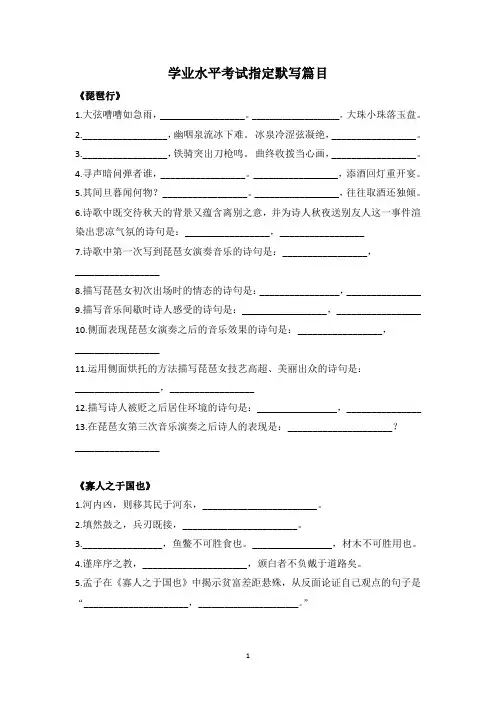
学业水平考试指定默写篇目《琵琶行》1.大弦嘈嘈如急雨,_________________。
____________________,大珠小珠落玉盘。
2._________________,幽咽泉流冰下难。
冰泉冷涩弦凝绝,_________________。
3._________________,铁骑突出刀枪鸣。
曲终收拨当心画,_________________。
4.寻声暗问弹者谁,_________________。
_________________,添酒回灯重开宴。
5.其间旦暮闻何物?_________________。
_________________,往往取酒还独倾。
6.诗歌中既交待秋天的背景又蕴含离别之意,并为诗人秋夜送别友人这一事件渲染出悲凉气氛的诗句是:_________________,_________________7.诗歌中第一次写到琵琶女演奏音乐的诗句是:_________________,_________________8.描写琵琶女初次出场时的情态的诗句是:________________,_______________9.描写音乐间歇时诗人感受的诗句是:_________________,_________________10.侧面表现琵琶女演奏之后的音乐效果的诗句是:_________________,_________________11.运用侧面烘托的方法描写琵琶女技艺高超、美丽出众的诗句是:_________________,_________________12.描写诗人被贬之后居住环境的诗句是:________________,_______________13.在琵琶女第三次音乐演奏之后诗人的表现是:_____________________?_________________《寡人之于国也》1.河内凶,则移其民于河东,_______________________。
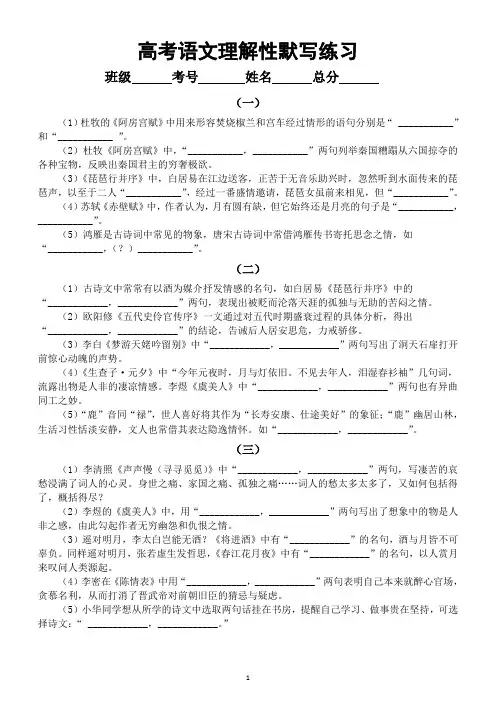
高考语文理解性默写练习班级考号姓名总分(一)(1)杜牧的《阿房宫赋》中用来形容焚烧椒兰和宫车经过情形的语句分别是“ ___________”和“___________ ”。
(2)杜牧《阿房宫赋》中,“___________,___________”两句列举秦国糟蹋从六国掠夺的各种宝物,反映出秦国君主的穷奢极欲。
(3)《琵琶行并序》中,白居易在江边送客,正苦于无音乐助兴时,忽然听到水面传来的琵琶声,以至于二人“___________”,经过一番盛情邀请,琵琶女虽前来相见,但“___________”。
(4)苏轼《赤壁赋》中,作者认为,月有圆有缺,但它始终还是月亮的句子是“___________,___________”。
(5)鸿雁是古诗词中常见的物象,唐宋古诗词中常借鸿雁传书寄托思念之情,如“___________,(?)___________”。
(二)(1)古诗文中常常有以酒为媒介抒发情感的名句,如白居易《琵琶行并序》中的“____________,____________”两句,表现出被贬而沦落天涯的孤独与无助的苦闷之情。
(2)欧阳修《五代史伶官传序》一文通过对五代时期盛衰过程的具体分析,得出“____________,____________”的结论,告诫后人居安思危,力戒骄侈。
(3)李白《梦游天姥吟留别》中“____________,____________”两句写出了洞天石扉打开前惊心动魄的声势。
(4)《生查子·元夕》中“今年元夜时,月与灯依旧。
不见去年人,泪湿春衫袖”几句词,流露出物是人非的凄凉情感。
李煜《虞美人》中“____________,____________”两句也有异曲同工之妙。
(5)“鹿”音同“禄”,世人喜好将其作为“长寿安康、仕途美好”的象征;“鹿”幽居山林,生活习性恬淡安静,文人也常借其表达隐逸情怀。
如“____________,____________”。
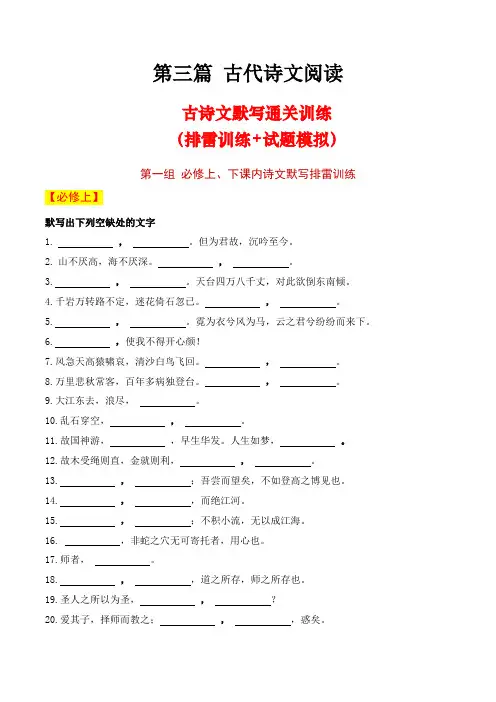
第三篇古代诗文阅读古诗文默写通关训练(排雷训练+试题模拟)第一组必修上、下课内诗文默写排雷训练【必修上】默写出下列空缺处的文字1.,。
但为君故,沉吟至今。
2.山不厌高,海不厌深。
,。
3.,。
天台四万八千丈,对此欲倒东南倾。
4.千岩万转路不定,迷花倚石忽已。
,。
5.,。
霓为衣兮风为马,云之君兮纷纷而来下。
6.,使我不得开心颜!7.风急天高猿啸哀,清沙白鸟飞回。
,。
8.万里悲秋常客,百年多病独登台。
,。
9.大江东去,浪尽,。
10.乱石穿空,,。
11.故国神游,,早生华发。
人生如梦,。
12.故木受绳则直,金就则利,,。
13.,;吾尝而望矣,不如登高之博见也。
14.,,而绝江河。
15.,;不积小流,无以成江海。
16.,非蛇之穴无可寄托者,用心也。
17.师者,。
18.,,道之所存,师之所存也。
19.圣人之所以为圣,,?20.爱其子,择师而教之;,,惑矣。
21.,,非吾所谓传其道解其惑者也。
22.,,闻道有先后,术业有专攻,如是而已。
23.清风徐来,水波不兴。
举酒属客,,。
24.浩浩乎如虚御风,而不知其所止;,。
25.其声呜呜然,如怨如慕,如泣如诉,,。
26.,泣孤舟之妇。
27.舳舻千里,旌旗蔽空,,,固一世之雄也,而今安在哉?28.,,驾一叶之扁舟,举樽以相属。
29.,。
哀吾生之须臾,羡长江之无穷。
30.,,耳得之而为声,目遇之而成色,取之无禁,用之不竭,,。
”【答案】1.青青子,悠悠我心。
2.周公吐,天下归心。
3.天姥连天向天横,势五岳掩赤城。
4.熊咆龙吟岩泉,栗深林兮惊层。
5.青浩荡不见底,日月照耀金银台。
6.安能眉折腰事权贵7.无边落木萧萧下,不尽长江滚滚来。
8.艰难苦恨霜鬓,潦倒新停浊酒杯。
9.千古风流人物。
10.惊涛拍岸,卷起千堆雪。
11.多情应笑我一还酹江月。
12.君子博学而日参省乎己,则明而行无过矣。
13.吾尝终日而思矣,不如须臾之所学也14.假舟楫者,非能水也15.故不积跬步,无以至千里16.蟹六跪而二螯17.所以传道业解惑也。
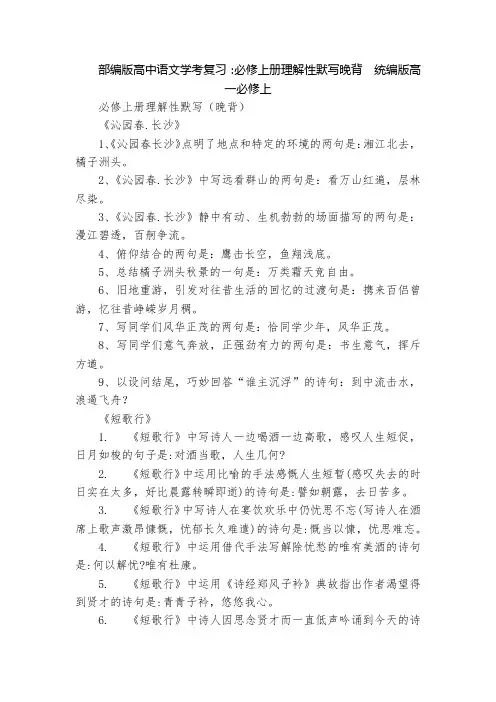
部编版高中语文学考复习:必修上册理解性默写晚背统编版高一必修上必修上册理解性默写(晚背)《沁园春.长沙》1、《沁园春长沙》点明了地点和特定的环境的两句是:湘江北去,橘子洲头。
2、《沁园春.长沙》中写远看群山的两句是:看万山红遍,层林尽染。
3、《沁园春.长沙》静中有动、生机勃勃的场面描写的两句是:漫江碧透,百舸争流。
4、俯仰结合的两句是:鹰击长空,鱼翔浅底。
5、总结橘子洲头秋景的一句是:万类霜天竞自由。
6、旧地重游,引发对往昔生活的回忆的过渡句是:携来百侣曾游,忆往昔峥嵘岁月稠。
7、写同学们风华正茂的两句是:恰同学少年,风华正茂。
8、写同学们意气奔放,正强劲有力的两句是:书生意气,挥斥方遒。
9、以设问结尾,巧妙回答“谁主沉浮”的诗句:到中流击水,浪遏飞舟?《短歌行》1. 《短歌行》中写诗人一边喝酒一边高歌,感叹人生短促,日月如梭的句子是:对酒当歌,人生几何?2. 《短歌行》中运用比喻的手法感慨人生短暂(感叹失去的时日实在太多,好比晨露转瞬即逝)的诗句是:譬如朝露,去日苦多。
3. 《短歌行》中写诗人在宴饮欢乐中仍忧思不忘(写诗人在酒席上歌声激昂慷慨,忧郁长久难遣)的诗句是:慨当以慷,忧思难忘。
4. 《短歌行》中运用借代手法写解除忧愁的唯有美酒的诗句是:何以解忧?唯有杜康。
5. 《短歌行》中运用《诗经郑风子衿》典故指出作者渴望得到贤才的诗句是:青青子衿,悠悠我心。
6. 《短歌行》中诗人因思念贤才而一直低声吟诵到今天的诗句是:但为君故,沉吟至今。
7. 《短歌行》中运用比兴手法,将贤才喻为明月,恰如其分地表达诗人渴望贤才来归的心意的诗句是:明明如月,何时可掇?8. 《短歌行》中写诗人通过想象贤才踏着田间小路,一个个屈驾前来探望我的诗句是:越陌度阡,枉用相存。
9. 《短歌行》中写诗人诗人通过想象与贤才彼此久别重逢,谈心宴饮,争着将往日的情谊诉说。
表达了诗人希望与贤才真诚交往的强烈愿望的句子是:契阔谈,心念旧恩。
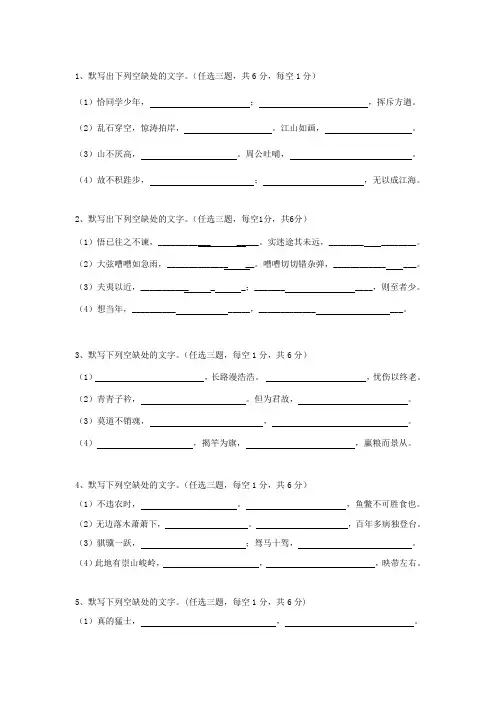
1、默写出下列空缺处的文字。
(任选三题,共6分,每空1分)(1)恰同学少年,;,挥斥方遒。
(2)乱石穿空,惊涛拍岸,。
江山如画,。
(3)山不厌高,。
周公吐哺,。
(4)故不积跬步,;,无以成江海。
2、默写出下列空缺处的文字。
(任选三题,每空1分,共6分)(1)悟已往之不谏,____________ _____。
实迷途其未远,________ ________。
(2)大弦嘈嘈如急雨,______________ __。
嘈嘈切切错杂弹,____________ ___。
(3)夫夷以近,___________ _ _;_______ ____,则至者少。
(4)想当年,__________ _____,_____________ ___。
3、默写下列空缺处的文字。
(任选三题,每空1分,共6分)(1),长路漫浩浩。
,忧伤以终老。
(2)青青子衿,。
但为君故,。
(3)莫道不销魂,,。
(4),揭竿为旗,,赢粮而景从。
4、默写下列空缺处的文字。
(任选三题,每空1分,共6分)(1)不违农时,。
,鱼鳖不可胜食也。
(2)无边落木萧萧下,。
,百年多病独登台。
(3)骐骥一跃,;驽马十驾,。
(4)此地有崇山峻岭,,,映带左右。
5、默写下列空缺处的文字。
(任选三题,每空1分,共6分)(1)真的猛士,,。
(2)榆柳荫后檐,。
暧暧远人村,。
(3),孤舟一系故园心。
,白帝城高急暮砧。
(4)大江东去,,。
6、默写出下列空缺处的文字。
(任选三题,每空1分,共6分)(1)不见复关,。
既见复关,。
(2)剑阁峥嵘而崔嵬,,。
(3)惟江上之清风,与山间之明月,,。
(4)复为慷慨羽声,,。
7、默写出下列空缺处的文字。
(任选三题,每空1分,共6分)(1)月明星稀,,,何枝可依?(2)把吴钩看了,,无人会,。
(3),是夕阳中的新娘;,在我的心头荡漾。
(4)臣少多疾病,,,至于成立。
8、默写出下列空缺处的文字。
(任选三题,每空1分,共6分)(1)又前而为歌曰:“,!”(2)其声呜呜然,如怨如慕,,余音袅袅,。
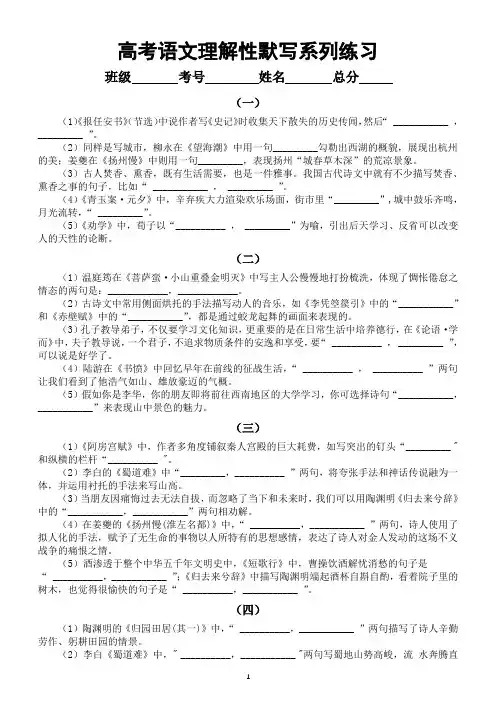
高考语文理解性默写系列练习班级考号姓名总分(一)(1)《报任安书》(节选)中说作者写《史记》时收集天下散失的历史传闻,然后“ ___________ ,_________ ”。
(2)同样是写城市,柳永在《望海潮》中用一句_________勾勒出西湖的概貌,展现出杭州的美;姜夔在《扬州慢》中则用一句_________,表现扬州“城春草木深”的荒凉景象。
(3)古人焚香、熏香,既有生活需要,也是一件雅事。
我国古代诗文中就有不少描写焚香、熏香之事的句子,比如“ ___________ , _________ ”。
(4)《青玉案·元夕》中,辛弃疾大力渲染欢乐场面,街市里“_________”,城中鼓乐齐鸣,月光流转,“ _________”。
(5)《劝学》中,荀子以“__________ , _________”为喻,引出后天学习、反省可以改变人的天性的论断。
(二)(1)温庭筠在《菩萨蛮·小山重叠金明灭》中写主人公慢慢地打扮梳洗,体现了惆怅倦怠之情态的两句是:____________,____________。
(2)古诗文中常用侧面烘托的手法描写动人的音乐,如《李凭箜篌引》中的“___________”和《赤壁赋》中的“___________”,都是通过蛟龙起舞的画面来表现的。
(3)孔子教导弟子,不仅要学习文化知识,更重要的是在日常生活中培养德行,在《论语·学而》中,夫子教导说,一个君子,不追求物质条件的安逸和享受,要“ __________ , _________ ”,可以说是好学了。
(4)陆游在《书愤》中回忆早年在前线的征战生活,“ __________ , __________ ”两句让我们看到了他浩气如山、雄放豪迈的气概。
(5)假如你是李华,你的朋友即将前往西南地区的大学学习,你可选择诗句“___________,___________”来表现山中景色的魅力。
(三)(1)《阿房宫赋》中,作者多角度铺叙秦人宫殿的巨大耗费,如写突出的钉头“_________ "和纵横的栏杆“__________ "。
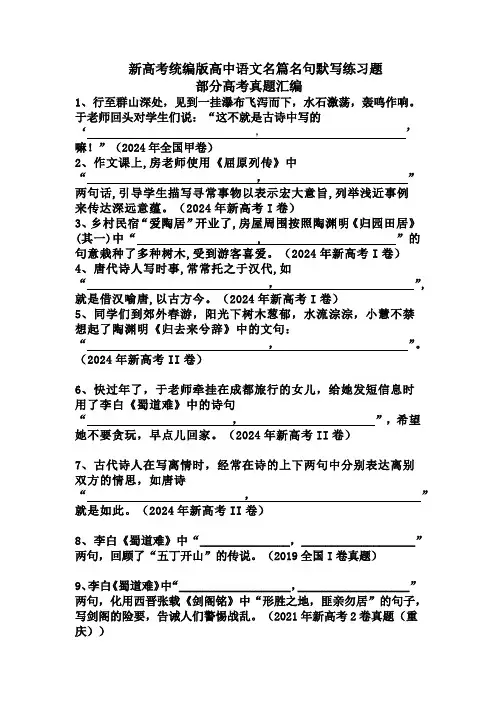
新高考统编版高中语文名篇名句默写练习题部分高考真题汇编1、行至群山深处,见到一挂瀑布飞泻而下,水石激荡,轰鸣作响。
‘,’2、作文课上,房老师使用《屈原列传》中“,”两句话,引导学生描写寻常事物以表示宏大意旨,列举浅近事例来传达深远意蕴。
(2024年新高考I卷)3、乡村民宿“爱陶居”开业了,房屋周围按照陶渊明《归园田居》(其一)中“, ”的句意栽种了多种树木,受到游客喜爱。
(2024年新高考I卷)4、唐代诗人写时事,常常托之于汉代,如“,”,就是借汉喻唐,以古方今。
(2024年新高考I卷)5、同学们到郊外春游,阳光下树木葱郁,水流淙淙,小慧不禁想起了陶渊明《归去来兮辞》中的文句:“,”。
(2024年新高考II卷)6、快过年了,于老师牵挂在成都旅行的女儿,给她发短信息时用了李白《蜀道难》中的诗句“,”,希望她不要贪玩,早点儿回家。
(2024年新高考II卷)7、古代诗人在写离情时,经常在诗的上下两句中分别表达离别双方的情思,如唐诗“,”就是如此。
(2024年新高考II卷)8、李白《蜀道难》中“_______________,___________________”两句,回顾了“五丁开山”的传说。
(2019全国I卷真题)9、李白《蜀道难》中“___________________,___________________”两句,化用西晋张载《剑阁铭》中“形胜之地,匪亲勿居”的句子,写剑阁的险要,告诫人们警惕战乱。
(2021年新高考2卷真题(重庆))10、《屈原列传》中,屈原感受到君王听信谗言的句子是:____________,_____________。
(2021年新高考I卷(江苏))11、李商隐《锦瑟》“__________,_________ ”两句中的数目字,引发了后世读者的多种解读。
(2022·全国乙卷·高考真题)12、小刚临摹了一幅诸葛亮的画像,想在上面题两句诗,却一直没想好。
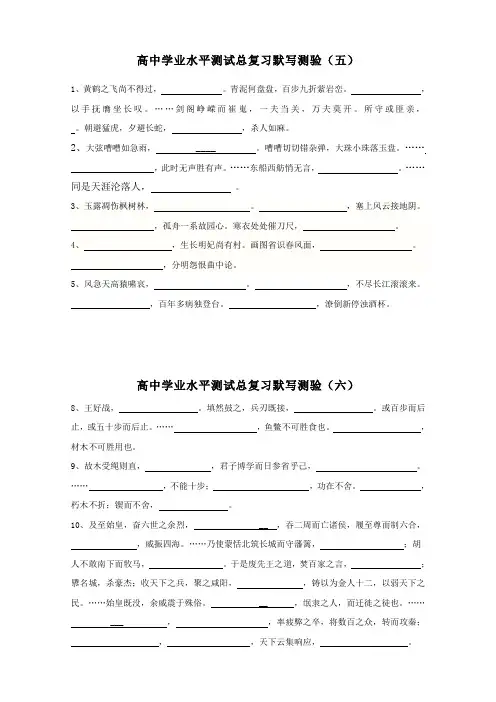
高中学业水平测试总复习默写测验(五)1、黄鹤之飞尚不得过,。
青泥何盘盘,百步九折萦岩峦。
,以手抚膺坐长叹。
……剑阁峥嵘而崔嵬,一夫当关,万夫莫开。
所守或匪亲,。
朝避猛虎,夕避长蛇,,杀人如麻。
2、大弦嘈嘈如急雨, ____ 。
嘈嘈切切错杂弹,大珠小珠落玉盘。
……,此时无声胜有声。
……东船西舫悄无言,。
……同是天涯沦落人,。
3、玉露凋伤枫树林,。
,塞上风云接地阴。
,孤舟一系故园心。
寒衣处处催刀尺,。
4、,生长明妃尚有村。
画图省识春风面,。
,分明怨恨曲中论。
5、风急天高猿啸哀,。
,不尽长江滚滚来。
,百年多病独登台。
,潦倒新停浊酒杯。
高中学业水平测试总复习默写测验(六)8、王好战,。
填然鼓之,兵刃既接,。
或百步而后止,或五十步而后止。
……,鱼鳖不可胜食也。
,材木不可胜用也。
9、故木受绳则直,,君子博学而日参省乎己,。
……,不能十步;,功在不舍。
,朽木不折;锲而不舍,。
10、及至始皇,奋六世之余烈, __ ,吞二周而亡诸侯,履至尊而制六合,,威振四海。
……乃使蒙恬北筑长城而守藩篱,;胡人不敢南下而牧马,。
于是废先王之道,焚百家之言,;隳名城,杀豪杰;收天下之兵,聚之咸阳,,铸以为金人十二,以弱天下之民。
……始皇既没,余威震于殊俗。
__ ,氓隶之人,而迁徙之徒也。
…… ___ ,,率疲弊之卒,将数百之众,转而攻秦;,,天下云集响应,。
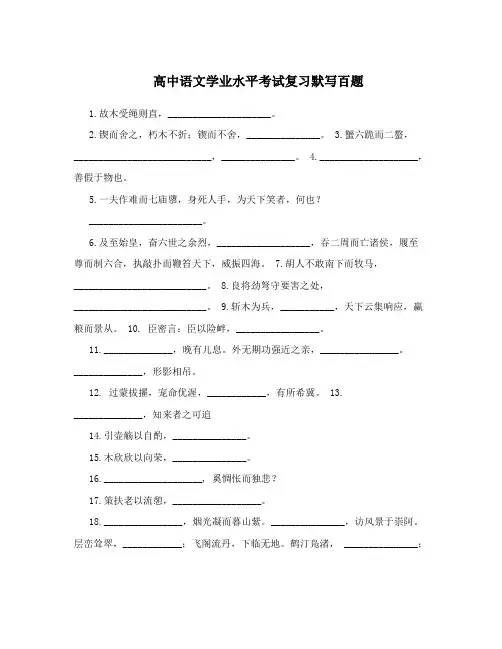
高中语文学业水平考试复习默写百题1.故木受绳则直,_____________________。
2.锲而舍之,朽木不折;锲而不舍,_______________。
3.蟹六跪而二螯,____________________________,_______________。
4.____________________,善假于物也。
5.一夫作难而七庙隳,身死人手,为天下笑者,何也?_______________________。
6.及至始皇,奋六世之余烈,___________________,吞二周而亡诸侯,履至尊而制六合,执敲扑而鞭笞天下,威振四海。
7.胡人不敢南下而牧马,___________________________。
8.良将劲弩守要害之处,___________________________。
9.斩木为兵,___________,天下云集响应,赢粮而景从。
10. 臣密言:臣以险衅,_________________。
11.______________,晚有儿息。
外无期功强近之亲,________________。
______________,形影相吊。
12. 过蒙拔擢,宠命优渥,____________,有所希冀。
13.______________,知来者之可追14.引壶觞以自酌,_______________。
15.木欣欣以向荣,_______________。
16.____________________, 奚惆怅而独悲?17.策扶老以流憩,__________________。
18.________________,烟光凝而暮山紫。
_______________,访风景于崇阿。
层峦耸翠,____________;飞阁流丹,下临无地。
鹤汀凫渚, _______________;桂殿兰宫,__________________。
19._______________,秋水共长天一色。

高考语文最新名校情景默写练习班级考号姓名总分(河南省信阳市高级中学2023-2024学年高三9月月考)补写出下列句子中的空缺部分。
(1)李密在《陈情表》中直接解释祖母对其有养育之恩的句子是“________,________”。
(2)苏轼在《石钟山记》中,写李渤在潭上找到了两块石头,然后就“ ________”;他认为李渤这样依靠斧斤敲击寻求石钟山得名的原因,还“________”,实在是见识短浅,令人可笑。
(3)刘星同学在写《杏花的故事》时,想引用唐宋时期的诗句来表明杏花自古以来就深得人们喜爱,用以表现春意,或用以寓意幸福,他引用的诗句是“________,________”。
(江苏省2023-2024学年高三上学期开学检测)补写出下列句子中的空缺部分。
(1)高适《燕歌行》中,“____________”通过前方的急报侧面写出了敌人进攻速度之快,“____________ ”则直接描写了敌军侵袭时的来势汹汹。
(2)教育应该尊重孩子的成长规律,呵护其天性。
柳宗元《种树郭橐驼传》中,“____________ ,____________”与这种理念完全契合。
(3)“门”是古诗常用意象,其“开”与“关”往往寄寓了作者不同的心境。
杜甫《客至》中,“____________ ”写出迎接客人来访的欣喜;陶渊明《归去来兮辞》中,“____________ ”写出诗人隐逸幽居的淡然。
(湖北省武汉市部分学校2023-2024学年高三9月月考)补写出下列句子中的空缺部分。
(1)辛弃疾《青玉案·元夕》中,抒情主人公历经千百次寻觅后,蓦然回首,惊喜发现“_______________,_______________”。
(2)欧阳修《五代史伶官传序》一文通过对五代时期盛衰过程的具体分析,得出“_______________,_______________”的结论,告诫后人居安思危,力戒骄侈。
(3)古人常通过“吟”或“啸”的方式吐露心曲,抒发情怀,古代诗文中对此也多有描述,如:“_______________,_______________ 。
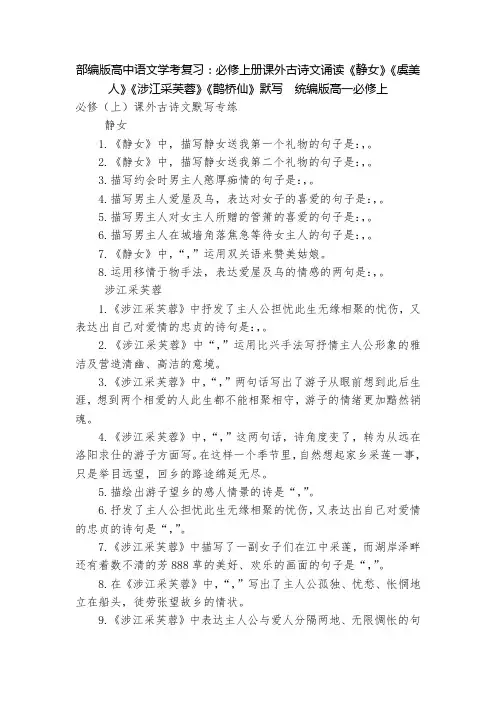
部编版高中语文学考复习:必修上册课外古诗文诵读《静女》《虞美人》《涉江采芙蓉》《鹊桥仙》默写统编版高一必修上必修(上)课外古诗文默写专练静女1.《静女》中,描写静女送我第一个礼物的句子是:,。
2.《静女》中,描写静女送我第二个礼物的句子是:,。
3.描写约会时男主人憨厚痴情的句子是:,。
4.描写男主人爱屋及乌,表达对女子的喜爱的句子是:,。
5.描写男主人对女主人所赠的管箫的喜爱的句子是:,。
6.描写男主人在城墙角落焦急等待女主人的句子是:,。
7.《静女》中,“,”运用双关语来赞美姑娘。
8.运用移情于物手法,表达爱屋及乌的情感的两句是:,。
涉江采芙蓉1.《涉江采芙蓉》中抒发了主人公担忧此生无缘相聚的忧伤,又表达出自己对爱情的忠贞的诗句是:,。
2.《涉江采芙蓉》中“,”运用比兴手法写抒情主人公形象的雅洁及营造清幽、高洁的意境。
3.《涉江采芙蓉》中,“,”两句话写出了游子从眼前想到此后生涯,想到两个相爱的人此生都不能相聚相守,游子的情绪更加黯然销魂。
4.《涉江采芙蓉》中,“,”这两句话,诗角度变了,转为从远在洛阳求仕的游子方面写。
在这样一个季节里,自然想起家乡采莲一事,只是举目远望,回乡的路途绵延无尽。
5.描绘出游子望乡的感人情景的诗是“,”。
6.抒发了主人公担忧此生无缘相聚的忧伤,又表达出自己对爱情的忠贞的诗句是“,”。
7.《涉江采芙蓉》中描写了一副女子们在江中采莲,而湖岸泽畔还有着数不清的芳888草的美好、欢乐的画面的句子是“,”。
8.在《涉江采芙蓉》中,“,”写出了主人公孤独、忧愁、怅惘地立在船头,徒劳张望故乡的情状。
9.《涉江采芙蓉》中表达主人公与爱人分隔两地、无限惆怅的句子是:,。
10《涉江采芙蓉》中,“,”两句描写诗人在长满香草的水泽中采摘荷花的景象。
11.《涉江采芙蓉》中,采用比兴手法写抒情主人公形象的雅洁及营造清幽、高洁的意境的句子是:,。
鹊桥仙1.秦观在《鹊桥仙(纤云弄巧)》中赞叹牛郎织女一年一度的七夕相会胜似人间长相厮守的美好,正是“,。
2023年中职学考语文默写练习班级姓名成绩1.无边落木萧萧下,。
(杜甫《登高》)2.我们分担寒潮、风雷、霹雳;。
(舒婷《致橡树》)3.执手相看泪眼,。
(柳永《雨霖铃》)4.君不见黄河之水天上来,。
(李白《将进酒》)5.乱石穿空,惊涛拍岸,。
(苏轼《念奴娇·赤壁怀古》)6.指点江山,,粪土当年万户侯。
(毛泽东《沁园春·长沙》)7.积善成德,,圣心备焉。
(荀子《劝学》)8. ,无人知是荔枝来。
(杜牧《过华清宫》)9.羽扇纶巾,谈笑间,。
(苏轼《念奴娇·赤壁怀古》)10. ,千金散尽还复来。
(李白《将进酒》)11. 师者,所以。
(韩愈《师说》)12.众里寻他千百度,。
(辛弃疾《青玉案·元夕》)13.何以解忧,。
(曹操《短歌行》)14.云中谁寄锦书来,雁字回时,。
(李清照《一剪梅》)15.竹喧归浣女,。
(王维《山居秋暝》)16.《短歌行》中体现作者广纳贤才,统一国家的决心的诗句是:,。
17.《归田居》中最能凸显诗人弃尘俗,不与世俗同流合污的诗句是:,。
18.《登高》中用落叶和江水抒发时光易逝、壮志难酬的感伤的句子是: ,。
19.《将进酒》表现了诗人对自己才能力量的充分肯定和屡遭失败之后不肯屈服的倔强性格的诗句是: ,。
20.《过华清宫》中揭露了皇帝为讨宠妃欢心无所不为的荒唐的诗句是: ,。
21.《念奴娇·赤壁怀古》中表现词人凭吊英雄人物,抒发自己壮志难酬的苦闷心情,只好以一杯清酒祭月的诗句是: ,。
22.李清照在《一剪梅》中引用范仲淹《御街行》中的“都来此事,眉间心上,无计相回避”的句子是: ,。
23.《青玉案·元夕》中刻画了一位不慕荣华,甘守寂寞的一位美人形象的句子: ,。
24.《沁园春·长沙》中,面对大千世界,诗人发出慨叹,表现诗人的雄心壮志的诗句: ,。
25.诗人徐志摩要和康桥离别,又生怕打扰惊醒了他心爱的康桥,《再别康桥》中“,。
高考语文理解性默写练习班级考号姓名总分(一)1.补写出下列句子中的空缺部分。
(6分)(1)高适《燕歌行·并序》中,“,”两句虚实结合,将战场上卫士的辛勒戍守与家中妻子的思念之苦表现得淋漓尽致。
(2)苏洵在《六国论》中指出燕虽小国却后亡的原因是“”,赵国自毁长城,“”导致武力抵抗不能延续到最后。
(3)小刚在设计新版话剧《梁祝》的人物台词时,为了表现男女主人公忠贞不渝的爱情,能够引用的诗词有“,”。
2.补写出下列句子中的空缺部分。
(6 分)(1)《五代史·伶官传序》引用《尚书》中的“满招损,谦得益”,结合庄宗得天下、失天下的史实,得出“,”的结论。
(2)陶渊明《归园田居(其)》中的“,”两句用白描手法静态描写了房屋周围树木茂盛的景象。
(3)小刚最近发表了一篇题为《漫话成语,巧学文言》的学术论文,文中提到了我国的成语有很多都来自古诗文,比如“善始善终”就源自魏征《谏太宗十思疏》里的“,”这句。
3.补写出下列句子中的空缺部分。
(1)《归园田居》中的“________,________”集中描写诗人做官时的心情,连用两个相似比喻,又是对仗句式,强化了厌倦官场生活,向往田园生活的情绪。
(2)苏轼在《赤壁赋》中,描写曹操军队攻破荆州后顺流而下的军容盛状的两句是“________,________”。
(3)自古以来,秋天一直是文人墨客常常吟味不已的季节。
借助秋景表达内心悲伤的诗句不胜枚举,如“________,________”就写出了秋天的凄清。
4.补写下列句子中的空缺部分。
(6分)(1)《桂枝香·金陵怀古》中,“, ”两句,色彩对比鲜明,动静相生,不仅把金陵秋景图展现得活灵活现,而且进一步开拓了观察的视野。
(2)《谏太宗十思疏》中,“, ”概括了历代君王能创业不能守业的普遍现象。
(3)第19届杭州亚运会闭幕式中,“攀花赠远人”的节目演绎了中国式的送别之礼,中国古典诗词里也有许多攀花赠人的诗句。
学业水平测试语文默写复习题附答案The following text is amended on 12 November 2020.2015学业水平测试语文默写模拟卷(一)1、江间波浪兼天涌,______________。
2、______________ ,小弦切切如私语。
3、举酒属客,诵明月之诗,______________。
4、山不厌高,______________。
5、又前而为歌曰:“,!”6、,油油的在水底招摇7、______________,忧伤以终老。
(二)1、惨象,2、呦呦鹿鸣,______________。
3、______________,性本爱丘山。
4、黄鹤之飞尚不得过,______________。
5、______________,四弦一声如裂帛。
6、千骑拥高牙,______________,吟赏烟霞。
7、寻寻觅觅,冷冷清清,______________。
8、______________,烟光凝而暮山紫。
(三)1、满载一船星辉,。
2、是臣尽节于陛下之日长,______________。
3、_____________ ,秋水共长天一色。
4、楚天千里清秋,______________ 。
5、念去去千里烟波,______________。
6、______________,而神明自得,圣心备焉。
7、采之欲遗谁______________。
8、______________ ,犹抱琵琶半遮面。
(四)1、今宵酒醒何处______________ 。
2、______________ ,而不知其所止3、______________,愁空山。
4、______________ ,不尽长江滚滚来。
5、假舟楫者,非能水也,______________。
6、东篱把酒黄昏后,______________。
7、外无期功强近之亲,______________。
8、臣所以去亲戚而事君者,。
(五)1、______________,留恋处,兰舟催发。
1、默写出下列空缺处的文字。
(任选三题,共6分,每空1分)
(1)恰同学少年,;,挥斥方遒。
(2)乱石穿空,惊涛拍岸,。
江山如画,。
(3)山不厌高,。
周公吐哺,。
(4)故不积跬步,;,无以成江海。
2、默写出下列空缺处的文字。
(任选三题,每空1分,共6分)
(1)悟已往之不谏,____________ _____。
实迷途其未远,________ ________。
(2)大弦嘈嘈如急雨,______________ __。
嘈嘈切切错杂弹,____________ ___。
(3)夫夷以近,___________ _ _;_______ ____,则至者少。
(4)想当年,__________ _____,_____________ ___。
3、默写下列空缺处的文字。
(任选三题,每空1分,共6分)
(1),长路漫浩浩。
,忧伤以终老。
(2)青青子衿,。
但为君故,。
(3)莫道不销魂,,。
(4),揭竿为旗,,赢粮而景从。
4、默写下列空缺处的文字。
(任选三题,每空1分,共6分)
(1)不违农时,。
,鱼鳖不可胜食也。
(2)无边落木萧萧下,。
,百年多病独登台。
(3)骐骥一跃,;驽马十驾,。
(4)此地有崇山峻岭,,,映带左右。
5、默写下列空缺处的文字。
(任选三题,每空1分,共6分)
(1)真的猛士,,。
(2)榆柳荫后檐,。
暧暧远人村,。
(3),孤舟一系故园心。
,白帝城高急暮砧。
(4)大江东去,,。
6、默写出下列空缺处的文字。
(任选三题,每空1分,共6分)
(1)不见复关,。
既见复关,。
(2)剑阁峥嵘而崔嵬,,。
(3)惟江上之清风,与山间之明月,,。
(4)复为慷慨羽声,,。
7、默写出下列空缺处的文字。
(任选三题,每空1分,共6分)
(1)月明星稀,,,何枝可依?(2)把吴钩看了,,无人会,。
(3),是夕阳中的新娘;,在我的心头荡漾。
(4)臣少多疾病,,,至于成立。
8、默写出下列空缺处的文字。
(任选三题,每空1分,共6分)
(1)又前而为歌曰:“,!”(2)其声呜呜然,如怨如慕,,余音袅袅,。
(3)千古江山,。
舞榭歌台,。
(4),内无应门五尺之僮,,形影相吊。
9、默写下列空缺处的文字。
(任选三题,每空1分,共6分)
(1)在雨的哀曲里,,。
(2)遥岑远目,,。
(3)渔舟唱晚,_________________ ;雁阵惊寒,_______________________。
(4)惨象,;流言,。
10、默写下列空缺处的文字。
(任选三题,每空1分,共6分)
(1),身死人手,为天下笑者,何也?。
(2),风飘飘而吹衣。
问征夫以前路,。
(3),谁怕?。
(4),池鱼思故渊。
开荒南野际,。
11、默写下列空缺处的文字。
(任选三题,每空1分,共6分)
(1),可以无悔矣,?此余之所得也。
(2),此时无声胜有声。
,铁骑突出刀枪鸣。
(3)士之耽兮,。
女之耽兮,。
(4)画图省识春风面,。
千载琵琶作胡语,。
12、默写下列空缺处的文字。
(任选三题,每空1分,共6分)
(1)仰观宇宙之大,,,足以极视听之娱。
(2)看万山红遍,;漫江碧透,。
(3)闾阎扑地,__________________ ___ _;__________________ _,青雀黄龙之轴。
(4)凭谁问:,。
13、默写下列空缺处的文字。
(任选三题,每空1分,共6分)
(1),,颁白者不负戴于道路矣。
(2)寻梦?撑一支长篙,,满载一船星辉,。
(3),而不知其所止;飘飘乎如遗世独立,。
(4),枯松倒挂倚绝壁。
,砯崖转石万壑雷。
14、默写下列空缺处的文字。
(任选三题,每空1分,共6分)
(1)假舆马者,非利足也,;假舟楫者,,而绝江河。
(2)寻寻觅觅,,。
(3),谈笑间,。
(4)云销雨霁,彩彻区明。
,。
15、默写下列空缺处的文字。
(任选三题,每空1分,共6分)
(1)既无伯叔,,,晚有儿息。
(2)上有六龙回日之高标,。
黄鹤之飞尚不得过,。
(3),渺沧海之一粟。
,羡长江之无穷。
(4)涉江采芙蓉,。
采之欲遗谁?。
16、默写下列空缺处的文字。
(任选三题,每空1分,共6分)
(1)指点江山,,。
(2)狗吠深巷中,。
,虚室有余闲。
(3),添酒回灯重开宴。
,犹抱琵琶半遮面。
(4)策扶老以流憩,。
,鸟倦飞而知还。
17、默写下列空缺处的文字。
(任选三题,每空1分,共6分)
(1)倩何人唤取,,。
(2),到黄昏、点点滴滴。
这次第,。
(3)故国神游,,早生华发。
人生如梦,。
(4),风雨兴焉;,蛟龙生焉。
18、默写下列空缺处的文字。
(任选三题,每空1分,共6分)
(1),巫山巫峡气萧森。
,塞上风云接地阴。
(2)女也不爽,。
,二三其德。
(3)___________ ,________________ 。
臣不胜犬马怖惧之情,谨拜表以闻。
(4)清风徐来,,举酒属客,诵明月之诗,。
19、默写下列空缺处的文字。
(任选三题,每空1分,共6分)
(1)呦呦鹿鸣,。
我有嘉宾,。
(2)群山万壑赴荆门,生长明妃尚有村。
,。
(3)悦亲戚之情话___________ 。
农人告余以春及,_______________ _ 。
(4)但见悲鸟号古木,。
,愁空山。
20、默写下列空缺处的文字。
(任选三题,每空1分,共6分)
(1)未尝不临文嗟悼,不能喻之于怀。
,。
(2),尽西风,。
(3)___________ ,不绝如缕。
舞幽壑之潜蛟,_______________ _ 。
(4)高渐离击筑,,,士皆垂泪涕泣。
望庐山瀑布
李白
日照香炉生紫烟,遥看瀑布挂前川。
飞流直下三千尺,疑是银河落九天。
湖口望庐山瀑布水
张九龄
万丈红泉落,迢迢半紫氛。
奔流下杂树,洒落出重云。
日照虹霓似,天清风雨闻。
灵山多秀色,空水共氤氲。
这两首诗都是描写庐山香炉峰瀑布的,但表达的思想感情不同:李诗描写了庐山瀑布的壮观,表达了诗人感情;张诗通过对庐山瀑布的赞美,抒发了诗人。
终南别业
王维
中岁颇好道,晚家南山陲。
兴来每独往,胜事空自知。
行到水穷处,生看云起时。
偶然值林叟,谈笑无还期。
【注释】王维,唐代著名诗人,官至尚书右丞, 本诗写于隐居终南山的时候。
要读懂诗歌,首先要理解诗句中字词的含义。
该诗首联中,“晚”的含义
为,“家”的含义为;颔联中“独往”、“空
15.晚年住家悠然自得自得其乐的闲适。